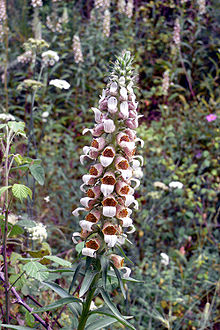Digitalis lanata
| Digitalis lanata | |
|---|---|
 |
|
| Digitalis lanata | |
| Scientific classification | |
| Kingdom: | Plantae |
| (unranked): | Angiosperms |
| (unranked): | Eudicots |
| (unranked): | Asterids |
| Order: | Lamiales |
| Family: | Plantaginaceae |
| Genus: | Digitalis |
| Species: | D. lanata |
| Binomial name | |
|
Digitalis lanata Ehrh., 1792 |
|
Digitalis lanata (often called woolly foxglove or Grecian foxglove) is a species of foxglove. It gets its name due to the texture of the leaves. Digitalis lanata, like some other foxglove species, is highly toxic in all parts of the plant. Even the ingestion of small amounts by humans can be fatal, particularly children . Symptoms of digitalis poisoning include nausea, vomiting, severe headache, dilated pupils, problems with eyesight, and convulsions at the worst level of toxicity. The plant is also harmful to other animals. In some cases it is considered invasive or a noxious weed. Minnesota is one of the few places that consider it invasive as noted by the Western Weed Society. It is in leaf all year, in flower in June and July, and the seeds ripen in early-mid September. The flowers are hermaphroditic (having both male and female organs). Bees pollinate the flowers.
The plant commonly grows from 0.3 to 0.6 meters in height, or about 13 to 26 inches. The plant prefers part shade and humus rich soil. The plant also prefers sandy, loamy, and clay soils. It can grow under dry or moist conditions. Seeds develop in pods that have small hooks, enabling the pods to be transported by animal fur or clothing. The elongated leaves are mid–green, wooly, veined, and covered with white hairs on the underside. They also have a very bitter taste. There is a tidy rosette before the spike goes up, and it is neatly arranged around the purple-tinged stems. The flowers are tubular and bell shaped with a creamy-white color and purplish-brown netting as well as a long broad lip. The flowers usually bloom in the second year. Both flowers and stems are also woolly or hairy.
It is found mostly in Eastern Europe. One of the biggest populations can be found near Bácsalmás in Hungary. Even though it is native to Europe, the plant can now be found throughout the world, growing in woodland areas, on roadsides, and in mountainous regions. In North America, it can be found mostly in the Northeast and Southwest regions. It is cultivated mainly in New York, Washington, Utah, and Colorado.
Global Distribution of Digitalis lanata
The Plantaginaceae family, also known as the plantain family, is a family of flowering plants included in the order Lamiales. The Plantaginaceae family was not originally placed in the order Lamiales, but in the order Plantaginales. However, in recent years phylogenetic studies conducted by the Angiosperm Phylogeny Group have indicated that it should be included in the order Lamiales. The original family name was Veronicaceae until 1789 when the family name became Plantaginaceae. This is the conserved name under the International Code of Botanical Nomenclature (ICBN). ICBN does not consider family names before 1789 for conservation, as a result Veronicaceae is not eligible for conservation. Digitalis lanata has several other common names such as "Grecian foxglove" and "woolly foxglove". The name Digitalis comes from the Latin word digitus, which means finger. Digitalis was first recorded in the English language in 1664 in a published work. This genus name was chosen because the German name for foxglove is Fingerhut, which means " finger hat" (thimble). The glove portion of the name originates from the similarity of the foxglove blossoms to the fingers of a glove.
...
Wikipedia
